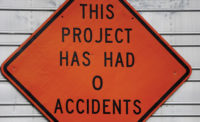To begin, your plan must be based on your organization’s vision for future safety performance. Frame it as a set of actions that will:
- Further a safety culture change from reactive to proactive
- Provide the functioning capability to lead the change
- Provide governance requirements to sustain the change.
Some actions are precursors, listed in the First Actions section of this plan. The other actions do not have to be implemented simultaneously, but they all should be completed within a reasonable timeframe.
First, describe your objective in measurable terms. Example: detail actions needed to further enable safety performance goals to be met and sustained in the most business effective, risk-sensitive ways.
Second, frame the scope you intend to deliver. Example: the safe construction, operation and maintenance of all facilities and the safety- related actions and behaviors of all employees and contractors.
Finally, facilitate the most rapid implementation of the plan by formatting it into first, core and sustaining actions.
- A First Actions summary includes essential actions and activities needed to jumpstart the change process. These include staff and timing, and need to be executed in the order listed.
- A Core Actions listing covers primary components to lead and manage the changes. Do this in the order best suited to the flow of normal business.
- A Sustaining Actions framework enables changes to become “the way people work.”
A fundamental tenet
Successful safety culture refinement has strong visible leadership and governance as their underpinning. The primary reason: an effective safety culture emphasizes “the line organization must be held accountable and responsible if injuries and incidents are to be sustainably eliminated.” Elements must include organizational, work and managing processes and personnel components. Implement these first actions in order and initiate immediately.Action 1: Designate a corporate-level leader as Safety Sponsor.
“Tone at the top” is critical for any culture shift. Usually, a CEO direct report is needed to ensure support and impact. Here are the sponsor’s key roles:
- Create alignment. Keep the change management project aligned with business and cultural goals.
- Communicate. Communicate a personal commitment to the work’s success frequently and in various venues. This includes executive level peers during normal business meetings and events.
- Gain commitment. Advocate for the change management project. “Walk the talk.” Gain commitment from key stakeholders.
- Arrange resources. Arrange resources necessary to initiate and sustain the change within the organization.
- Facilitate problem solving. Ensure issues escalated are solved at the right organizational level. This includes decisions on changes, risks, conflicting objectives and other issues outside of the change management project’s leader’s designated authority.
- Support the change management project leader. The sponsor offers mentoring, coaching and leadership when dealing with business and operational matters.
- Build durability. Sustain the project’s outputs by ensuring that people and processes are in place to maintain it once a steady state operation is reached.
Action 2: Convene executive level meeting to initiate culture change.
Include the executive management team and base discussion on their understanding of the current state related to safety performance and culture. Clarify their expectations of an acceptable future state. Trained facilitation can be helpful to design and conduct the meeting. The meeting must produce these deliverables:
- Corporate safety policy position. A formal policy statement is accompanied by specific goals and supporting metrics as part of the Core Action items.
- Designate a Safety Culture Change Project Leader/Champion. Usually this individual is assigned full time until the project has functioning capability to lead and sustain the change in place. It should be a “felt” leader from the line organization, with strong demonstrated leadership skills and broad credibility as an effective change agent who supports safety as a corporate value.
“FELT Leadership” characteristics
- Agree to charter a safety leadership team. This group is the primary engine driving needed changes. It is headed by the corporate sponsor and led by the Safety Culture Change Project Leader.
- Agree to emphasize safety accountability and responsibility in positions, performance discussions, and career development considerations. Everyone in the organization must be clear on leadership’s expectations for safety actions and behaviors, or culture change will be very slow and the current reactive vs. proactive culture will persist. These changes to the Human Resources practices should be made and communicated immediately.
Action 3: Charter a Safety Leadership Team with business and functional representation.
A robust Safety Leadership Team is essential to achieve an effective safety culture. The team is accountable for establishing and gaining approval of the project timeline to complete all the Core and Sustaining Actions. Functional and local safety committees and Process Improvement Teams (PITs) get the work done. Effective PITs use a seven-step methodology:
- Analyze the Current State/Process
- Map the Current Process (if present)
- Design Future State and/or Process
- Develop Future Process Map and Implementation Procedure
- Gain Approval for New Process and Procedure
- Pilot the New Business Process
- Implement and/or Rollout the New Process System-wide
Staff this team with people knowledgeable of “what works” in the current culture. They can assess change specifics as well as possible timelines. Normal staffing levels are five to seven people led by a line manager.
Want to improve your organization’s safety performance? The best time to start is now! Consider the “first actions” in this column as a guide to get your process started. Stay tuned for the next part of the series on “core actions” to formally initiate the needed culture change.
“Felt” Leadership: The art of leading when you are not there” key characteristics:
- Demonstrates personal commitment
- Pervades the organization
- Easily observable
- Active, not passive
- Central to the message, not an “afterthought” or “add-on”
- Face to face, not just an email
- Continuous, positive, not just when problems arise
- Reality based, not theoretical
- Affects and involves all levels of employees and contractors
- Not just traditional leaders, all employees can exhibit “felt leadership”
“Great leaders don’t create followers – They create more leaders” -Tom Peters



